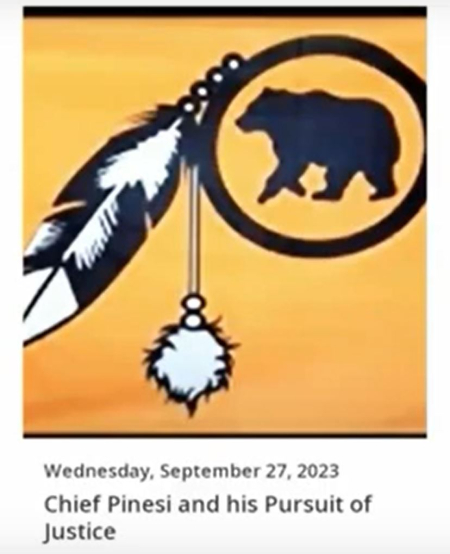Our first virtual speaker session of the year was held on September 27, 2023, and featured a pre-recorded presentation by Jim Stone, supported by Merv Sarazin who introduced Jim and remained with the presentation to answer questions and provide additional background. Jim, a retired Foreign Service officer and amateur historian, focussed his presentation on the life of Grand Chief Pierre Louis Constant Pinesi (1768 – 1834) and the turbulent times in which he lived. Jim also provided a more general history of the Alongkin* peoples of the Ottawa area in the 150 years or so prior to Chief Pinesi’s birth. Jim is not Indigenous himself and assembled the information for his presentation from published and archival sources, not traditional Alongkin knowledge, though he has consulted with the people of Pikwakanagan First Nation where a number of Chief Pinesi’s descendants live.
Jim described that, starting in the early 1600s, things began to go badly for the Alongkin people of the Ottawa valley. They were ravaged by a series of European diseases and their consequences. Later, they were driven from their lands by the Iroquois who were expanding their territory. As a result, the Ottawa valley became nearly depopulated. It was not until the signing of the Grand Peace of 1701 between the French, Alongkin, Iroquois and others, that the Alongkin began to return to this area.
Jim explained that prior to the influx of settlers, Alongkin family hunting grounds were fairly fixed and well respected. Chief Pinesi described his hunting grounds as being south of the Ottawa River, centered on the Rideau River. The exact boundaries, which would have followed natural land forms, are today unknown. Based on a meeting documented by Philemon Wright that he had with two Chiefs who were protesting his logging activities, it is possible that Chief Pinesi had some access to or use of lands to the north of the Ottawa River. Chief Pinesi and his family, he had 12 children, many of whom died young, would have travelled widely in his hunting grounds. He would also have travelled throughout the greater territory, especially to the Lake of Two Mountains, now Oka, where there was a summer gathering of Alongkin, Nipissing and Mohawk peoples, along with a French Catholic Mission.
Just prior to the 1800s, settlers began arriving in the Ottawa watershed. This resulted from the British domination of North America established by the Treaty of Paris in 1763 and spurred on by the American Revolution, which ended in 1783. Loggers cleared the forests, destroying the habitat of the animals hunted by the Alongkin, and settlers divided the land for farming. Both groups also competed for the same fish and animals that fed Chief Pinesi, his family and the other Alongkin people. Construction of the Rideau Canal was especially devastating. The dams required for the waterway, such as at Hog’s Back, transformed the river into a series of essentially long lakes, destroying fishing grounds at the base of rapids and flooding traditional camping and cultural sites along the shores and on its islands. The large workforce also accessed the same natural food sources, driving some species to near extinction in the area.
Chief Pinesi and four of his sons were among the many Indigenous warriors, Alongkin, Nipissing and Iroquois, who fought with the British in the war of 1812. Indigenous warriors are known to have fought at Queenston (October 13, 1812), Odeltown (August 19, 1812), Chateauguay (October 26, 1813) and Beaver Dams (June 24, 1813). Alongkin and Nipissing warriors were prominent in the capture of Colonel Boerstler's Detachment of 512 US soldiers at Beaver Dams. Jim emphasized that these warriors fought as allies, not as soldiers of the British army. Merv Sarazin commented that had it not been for the impact of Indigenous warriors, Canada as we know it might not exist, having fallen to the Americans at that time.
Jim pointed out that much of Chief Pinesi’s life was dedicated to attempting to protect his people’s rights to their ancestral lands and to their way of life. He submitted about 20 petitions, in conjunction with other Alongkin and Nipissing Chiefs, to the governments of Upper and Lower Canada seeking their acknowledgement to Alongkin title to their lands, compensation for lands already lost to settlers, and restrictions on further settlement. The governments did not act upon these petitions, despite the observation by Chief Pineisi that the Alongkins had helped defend the British interest in the area. In 1819, in response to pressure from the increasing number of settlers, the government of Upper Canada signed a treaty with Mississauga Chiefs that included the Alongkin lands of the Rideau River watershed, including Chief Pinesi’s family hunting grounds. No treaty for land compensation was ever signed with the Alongkin.
Chief Pinesi and his wife both died in August 1834 as a result of a Cholera epidemic that was sweeping Upper and Lower Canada. Jim believes that they are buried in the second Catholic cemetery at Lake of Two Mountains, though no record of the exact location of these graves survives.
You can watch Jim’s full presentation on the HSO YouTube channel.
A more complete written version of Jim’s work with footnotes can be downloaded from Grand Chief Constant Pinesi – Kichi Sibi Trails (kichisibiancienttrails.ca) .
Additional, Merv Sarazin referred to the book “The Ancestors are Arranging Things”, by Noreen Kruzich, available for purchase online or from the Ottawa Public Library.
*The term “Algonkin” is used to refer to the Anishinabeg living in the land claimed by Chief Pinesi on both sides of the Ottawa River and all its tributaries from Oka to Mattawa, including the headwaters of the latter river. The term Algonquin refers to a much larger group of Indigenous people. This term parallels that used by Noreen Kruzich in her book "The Ancestors are Arranging Things".






